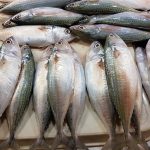 In the fourteenth century, and for many centuries after, the word mackerel meant two things: it referred to a North Atlantic fish, an important food source for the northern European nations; and it referred to someone who was a pimp or, as he would be called back then, a pander. One explanation that accounts for the two senses of the word is this: the Dutch word makelaar, meaning broker or pedlar, was adopted by Old French as maquerel and was used to mean pimp, a person who peddles flesh. This word was then adopted into Middle English as mackerel, still meaning pimp, but then also became the name of the fish because of the popular but unfounded belief that every spring mackerels guide female herring through the ocean to their mates. Although this explanation is tidy, it is not necessarily correct; it is possible, for instance, that the belief about mackerels leading female herrings to their mates arose as an explanation for why the fish had a name that meant pander, in other words, the name may have led to the belief, instead of the other way around. If so, then mackerel the fish and mackerel the pimp may simply be distinct, unrelated words, in which case the origin of mackerel the fish remains unknown. What is known, however, is that the expression Holy mackerel! arose as a euphemism for Holy Mary! a blasphemous exclamation of incredulity; similarly, Dog gone it! arose as a substitute for God damn it!
In the fourteenth century, and for many centuries after, the word mackerel meant two things: it referred to a North Atlantic fish, an important food source for the northern European nations; and it referred to someone who was a pimp or, as he would be called back then, a pander. One explanation that accounts for the two senses of the word is this: the Dutch word makelaar, meaning broker or pedlar, was adopted by Old French as maquerel and was used to mean pimp, a person who peddles flesh. This word was then adopted into Middle English as mackerel, still meaning pimp, but then also became the name of the fish because of the popular but unfounded belief that every spring mackerels guide female herring through the ocean to their mates. Although this explanation is tidy, it is not necessarily correct; it is possible, for instance, that the belief about mackerels leading female herrings to their mates arose as an explanation for why the fish had a name that meant pander, in other words, the name may have led to the belief, instead of the other way around. If so, then mackerel the fish and mackerel the pimp may simply be distinct, unrelated words, in which case the origin of mackerel the fish remains unknown. What is known, however, is that the expression Holy mackerel! arose as a euphemism for Holy Mary! a blasphemous exclamation of incredulity; similarly, Dog gone it! arose as a substitute for God damn it!
A North Atlantic species of oily or fatty fish, typically sporting a green hue adorned with blue stripes on its back and sides and a silver underside. The flesh of this fish is highly prized, especially that obtained during the initial catch of the season when the fish reach approximately sixteen inches in length.
A circular marine species discovered in the Pacific Ocean and both sides of the Atlantic, the mackerel undergoes its prime season from April to October, with April, May, and June considered the pinnacle months. Adorned with distinctively dark blue markings on its dorsal side and a shimmering silvery underbelly, this fish can reach a maximum length of 18 inches when fully matured. Its flesh possesses a rich oiliness, and the true essence of its flavor is best experienced when consumed fresh from the sea. On the western coast, the prevalent variety is the chub or Pacific mackerel, while the southern regions below the Chesapeake Bay are home to the significantly larger King mackerel. When procuring mackerel, it is crucial to ensure its absolute freshness. Opt for a specimen with clear eyes, vibrant pigmentation, and bright-red open gills. Additionally, the fish should exhibit rigidity, although this alone does not guarantee freshness, as stiffness may result from storage on ice. Alternatives such as frozen and canned mackerel are also accessible.
